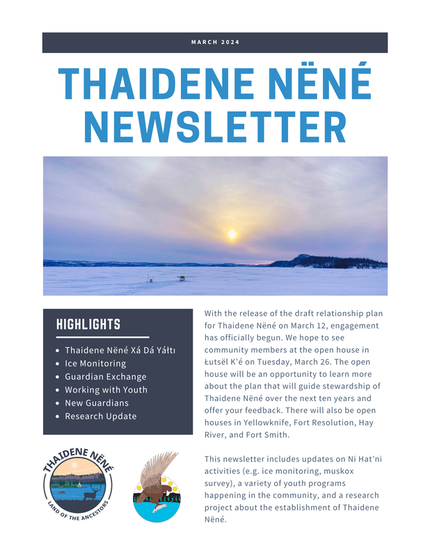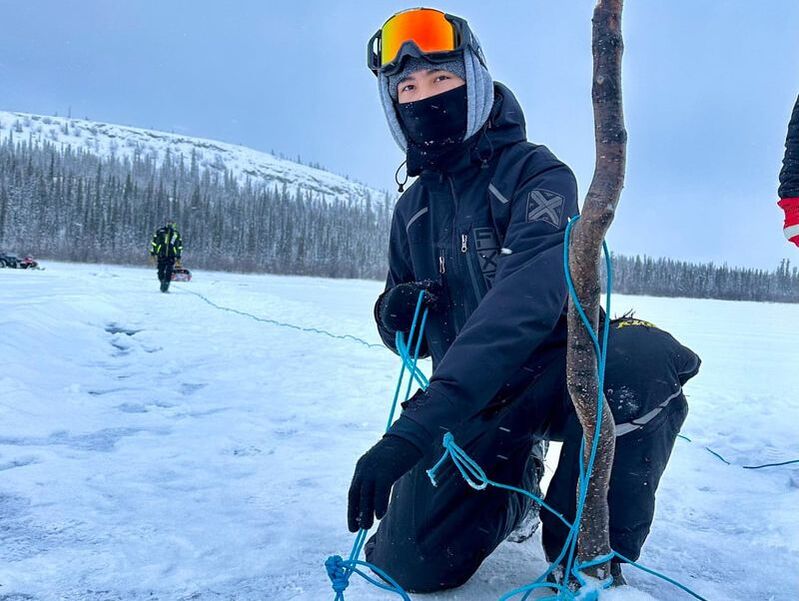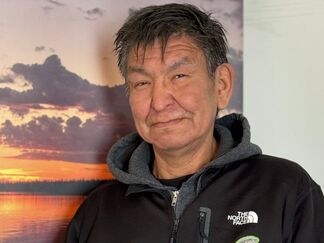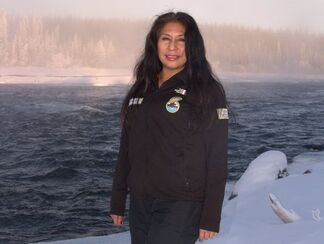 Engagement has officially begun for the relationship plan for Thaidene Nëné. We hope to see community members at the open house in Łutsël Kʼé on Tuesday, March 26. The open house will be an opportunity to learn more about the plan that will guide stewardship of Thaidene Nëné over the next ten years and offer your feedback. There will also be open houses in Yellowknife, Fort Resolution, Hay River, and Fort Smith. In addition to information about the relationship plan engagement, this newsletter includes updates on Ni Hat’ni activities (e.g. ice monitoring, muskox survey), a variety of youth programs happening in the community, and a research project about the establishment of Thaidene Nëné.  In 2022, Tanner Catholique was hired on as a summer student in Łutsël K’é’s Thaidene Nëné Department. The highlight of the summer was spending time on the water and visiting different places in the protected area. “We went on a couple of camping trips that I really enjoyed. We went to Reliance and to Wildbread Bay. We also did a lot of fishing. I really like fishing,” says Tanner. As a side note, when asked about the biggest fish he ever caught, Tanner reported that it was a 35-pound trout. Lucky for him, he landed it during a fishing derby. He came first and won $5,000 for his efforts. When Tanner learned that the Thaidene Nëné Department was looking for full-time guardians in June 2023, he applied. “I enjoyed my summer position,” he says, “so I thought I might like being a guardian full-time. Also, I didn’t want to sit behind a desk.” Ni Hat’ni Dene are more likely to be found sitting on skidoos or boats than at desks. Shortly after he started work as a guardian, Tanner was sent out on patrol. “We went to Taltheilei Narrows. We cleaned up an old cabin there.” Other activities in his first six months on the job have included hauling lumber to the new cabin site at Old Snowdrift and working with the lead carpenter on the build. “We’ve also been harvesting animals like moose, muskox, fish, rabbits, grouse, etc, and sharing that with community members and Elders,” Tanner explains. Tanner likes the fact that being a guardian allows him to stay active. He also appreciates the many and varied learning opportunities that come with the position. “I’ve been learning things like basic maintenance of quads and skidoos, how to site a gun, how to skin different animals,” he says. As he works alongside the older guardians, as well as Elders and knowledge keepers, Tanner is also being exposed to and absorbing critical Łutsël K’é Dene knowledge. Tanner says it was his mom, Iris, who showed him how to be on the land. “She brought me out to the Barrenlands when I was young.” Tanner was nine or ten when he harvested his first caribou near Ɂedacho Tué (Artillery Lake). “My papa [Matthew Fatt] had to hold my shoulder because the gun kicked me back.” Tanner is quiet and reserved, but he laughs when he tells this story. When he’s not working with the guardians, Tanner likes riding around on his skidoo or quad. He also enjoys going out on the land with his grandparents. “Granny always asks me to bring her out to Tomato Island for berry picking, making fire, catching fish, cooking the fish,” he says. Tanner identified two places in Thaidene Nëné that are special for him: Desnéthchée and Ts'ąkuı Thedá. Speaking about the spiritual gathering site, Tanner says, “I like how the community gets together there each year.” He also feels fortunate to have had a chance to visit Ts'ąkuı Thedá, the old lady of the falls. Tanner doesn’t see a lot of other young people in the community who are interested in doing the kinds of things he is doing as a guardian, but he hopes that changes because, in his words, “protecting Thaidene Nëné is important.” On March 12, Thaıdene Nëné Xá Dá Yáłtı, the operational management board for Thaidene Nëné, and shared management partners, including the Łutsël K’é Dene First Nation, Northwest Territory Métis Nation, Parks Canada, and the Government of Northwest Territories, released a draft relationship plan for Thaıdene Nëné, titled Thaıdene Nëné badı xá, for public comment.[1]
Thaıdene Nëné is an Indigenous protected area established in 2019. It is 26,376 square kilometers and is located within the territories of the Akaitcho Dene First Nations and the Northwest Territory Métis Nation in the Northwest Territories. Thaıdene Nëné includes a national park reserve, a territorial protected area, and a territorial wildlife conservation area. The relationship plan sets out a long-term vision, specific objectives, and strategic direction for the protected area. “The foundation of Thaıdene Nëné badı xá is nuwé ch’anıe. Nuwé ch’anıe is our Indigenous values and knowledge systems, including our relationships with and responsibilities to care for the land, water, and wildlife,” says Addie Jonasson, chairperson of Thaıdene Nëné Xá Dá Yáłtı. “This plan will lay the foundation for the future, ensuring countless generations to come will be able to care for and benefit from Thaidene Nëné. Our aim in releasing this draft to the public is to ensure Indigenous governments, stakeholders, and Canadians have an opportunity to provide input on the future direction of Thaıdene Nëné.” Thaıdene Nëné Xá Dá Yáłtı will be hosting a series of open houses over the next month. Events are currently scheduled in the communities of Łutsël Kʼé, Yellowknife, Fort Resolution, Hay River, and Fort Smith. The first open house will be held in Yellowknife on Monday March 25 from 6-8:30pm at the Tree of Peace Friendship Center (5011 51st Street). Thaıdene Nëné Xá Dá Yáłtı and the partners invite the public to attend and learn more about the draft plan. Light refreshments will be served. There will also be giveaways and the chance to win a number of prizes. Thaıdene Nëné Xá Dá Yáłtı is accepting comments from the public on the draft relationship plan until April 28, 2024. For more information about the plan and to download a copy, visit https://www.landoftheancestors.ca/relationshipplan.html or https://parks.canada.ca/pn-np/nt/thaidene-nene/info/plan. Beginning March 21, members of the public can also leave comments on the draft plan at www.haveyoursay.nwt.ca. [1] Thaıdene Nëné xá dá yáłtı is pronounced “thigh-denay nenay ha da yawl-ti.” Thaıdene Nëné badı xá is pronounced “thigh-denay nenay badi ha.”  Arthur Rabesca joined the Ni Hat’ni Dene crew in July 2023. He’s spent the last eight months patrolling Thaidene Nëné, interacting with visitors, cleaning up sites around the protected area, building and renovating cabins, and taking kids out on the land. The best part of being a guardian has been providing for his home community of Łutsël K’é. “Seeing the faces of the Elders when you hand them the goodies, seeing the smiles on their faces, that’s the highlight of my day.” Arthur was raised to help and to see the value of helping. “My grandpa always said, You’ll be very lucky, blessed if you do all that good stuff for other people. It will come back to you.” Helping others was one of a number of important lessons that Arthur learned from his grandparents, Mary Louise and J.B. Rabesca, who raised him. “My grandpa taught me the traditional ways. He taught me my language, trapping, hunting, fishing. He taught me to respect the land and the animals, to only take what you need. He had good wisdom.” Arthur grew up in town, in Łutsël K’é, but his grandparents took him out on the land every chance they got. “We would go hunting around the Łutsël K’é area. We’d go all the way down to Basile Bay, hunting, fishing, trapping. I know all of the area down that way.” One of the things that has been interesting for Arthur since becoming a guardian has been spending more time on the tundra. “I’d hardly been out on the barrenlands before this job, just a few times by plane when I was working with the mining companies. It’s different out there. I’m learning as I go. We all do.” Arthur is thankful for the opportunity with the Thaidene Nëné Department because it’s allowed him to come home. “I worked in the mines for about 10 years, from exploration camps to mining camps. I got tired of it. I got tired of being away from home. It’s not a job for a person with a family.” Arthur wanted to be a guardian because of the way that he was raised. “I wanted to teach others, like kids and people that don’t know. I wanted to teach them about the land, the language, the culture, our heritage. They need to learn all of that stuff, so they can pass it on to their families.” Arthur has three children and five grandchildren, so he’s aware of the other things that compete for young people’s attention. “Kids are too much into games and the internet. They’re not into learning their culture. I want to get them learning how to be on the land.” Arthur feels a deep responsibility to the land of his ancestors and also to future generations. “We have to take care of it, protect it from development, from mining,” he says of Thaidene Nëné. Arthur has firsthand experience of the impacts of mining, having worked on mines at different stages of development. “When I worked at exploration camps, it was so beautiful at the beginning. The lake, caribou, everything. Now I look at the mine and it’s one big hole, there’s no water. All that just for a little piece of rock. I don’t want to see that happen to Thaidene Nëné. We have to leave something for our kids.” When asked to name a special place in Thaidene Nëné, Arthur talked about Ts’ąkuı Thedá Dezé (Lockhart River) and Ts’ąkuı Thedá (Lady of the Falls). “Those are spiritual places,” he explains. “If you believe in the stories behind them, you will be taken care of.” He also has fond memories of the area around T’u Chogh Ka Tł’áázı̨ (Basile Bay), where his grandpa raised his family and where he used to trap and fish. “The house is gone, but the spot is still there. I go by sometimes because it reminds me of him. Reminds me of sitting by the woodstove in candlelight, listening to him tell stories. I’ll never forget what he taught me.”  Aileen Drybones has a unique story. She and her sister, Marlene, were raised by their grandparents, Madeline and Noel Drybones. Their main camp was at Kaché (Reliance), though the family spent a good part of each year travelling and living off the land. “We were raised to hunt and trap,” Aileen explains. In the fall time, before the ice formed, Aileen, Marlene, and their grandparents would pack up their snow machine, dog team, tents, gear, and food—they spent the weeks leading up to their departure harvesting fish and berries—and then charter a plane out to the tundra. They were dropped off at different places: Thelon River, Dené Bésda Tué Chogh (Fletcher Lake), Tł'ombálı Tué (Tent Lake), Beaulieu River, Ɂedacho Túe (Artillery Lake), Rabbit Lake, Batsı́z Káltth’ër Tué (Williams Lake), to name just a few. From there, the foursome would work their way back to Reliance, hunting and trapping along the way. The Drybones family truly depended on the land. “We did anything and everything to survive,” Aileen explains. “If you saw a ptarmigan, you didn’t just watch it walk past. That ptarmigan could be your lunch or your dinner.” They trapped marten and mink in the fall, foxes and wolverines in the winter, and beavers and muskrats in the spring. Eileen also remembers harvesting migrating caribou. “We would set up food caches under the rocks to keep the meat good and to protect it from grizzlies. You always need a few caches just in case.” In 2002, Aileen was living in Yellowknife. By this point she had two kids, one in school, the other in daycare. She was using her free time to do some upgrading at Aurora College. One day, she saw a poster on a bulletin board at the college for a taxidermy course. “I dropped what I was doing and took the course. I became a taxidermist.” In many respects, taxidermy was a natural career path for Aileen, who was already skilled at working with fur from hunting and trapping. Aileen loved being a taxidermist—she specialized in canines like foxes and wolves—but after twenty years, she needed a change. For a few years, she took contracts as a culture instructor for schools and non-profit organizations in Yellowknife. “I took kids on canoe trips in big boats and out on snowmobiles. I taught them how to trap, set snares, hunting in winter, reading animal tracks.” She continued to do this kind of work after moving to Łutsël K’é. Then this past year she saw the Thaidene Nëné Department’s posting for guardians. “I love being on the land,” Aileen explains. “The outdoors is home, it’s my happy place. I applied for this job because it allows me to be outside. I also like jobs that are physically demanding. The bigger the challenge, the bigger the reward and the sense of satisfaction.” Aileen joined the Ni Hat’ni Dene crew in July 2023. In addition to spending time outside and the physical challenge of the work, she has liked being part of a team. “I enjoy working with others. It’s not always easy. We have our disagreements, but we are stronger together.” She has also liked the fact that her job is to take care of the land. “I want to keep Thaidene Nëné the way it is. I don’t want exploration, people moving in, tearing up the land, polluting it. Protecting our land, the animals, and our people’s ways of life is super important for our future generations. We depend on the land; we live on our country food.” There are lots of special places for Aileen across Thaidene Nëné, places that remind her of the years she spent living, travelling, and learning with her grandparents. One particularly special place is Ɂedacho Túe. “It’s so beautiful there. One side of the lake is tundra. The other side is bush.” The Drybones family has a cabin where the lake empties into the river. “You can set a fish net right there because the ice isn’t too thick. If you go south from the cabin, you’re in the forest, so you can get wood easily. If you go north, you hit the tundra. You have everything you need. How can you not love it? It feels like the place where God first began." |
AuthorWrite something about yourself. No need to be fancy, just an overview. Archives
March 2024
Categories |
CONNECT |
VISIONWe are the Lutsel K’e Dene First Nation. Our vision for Thaidene Nëné is:
Nuwe néné, nuwe ch'anıé yunedhé xa (Our land, our culture for the future). We’re working with our partners to permanently protect Thaidene Nëné—part of our huge and bountiful homeland around and beyond the East Arm of Tu Nedhé. |
